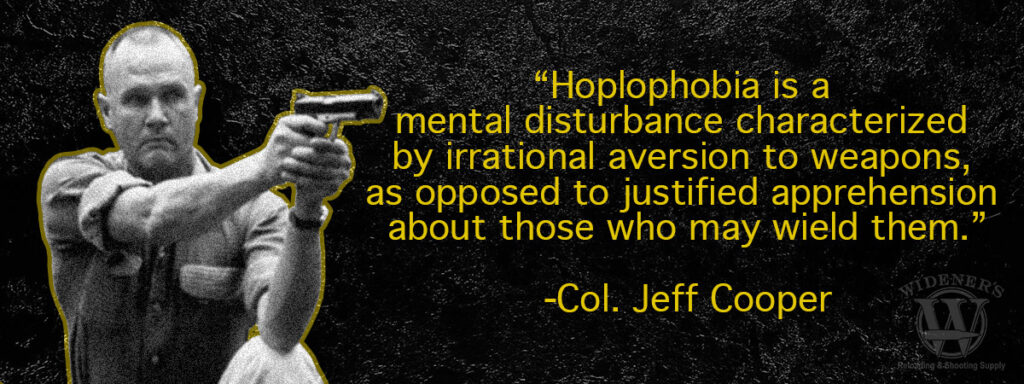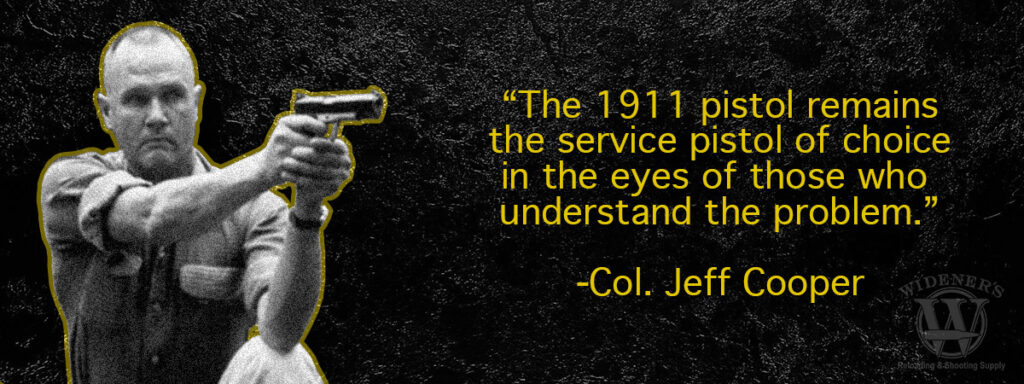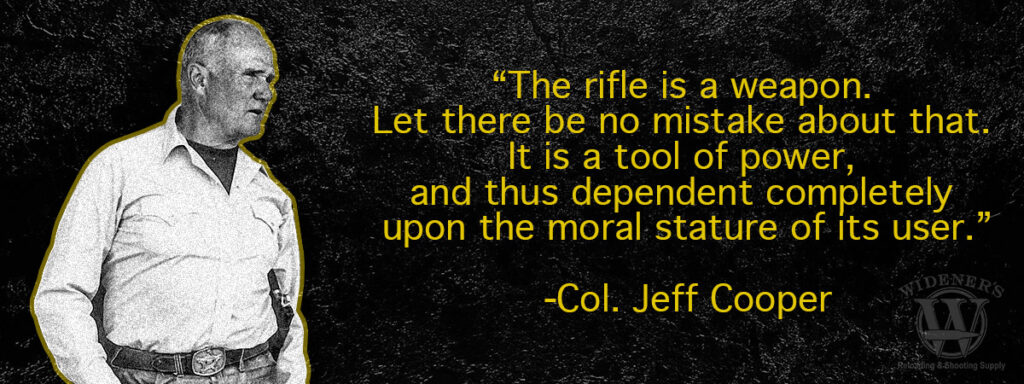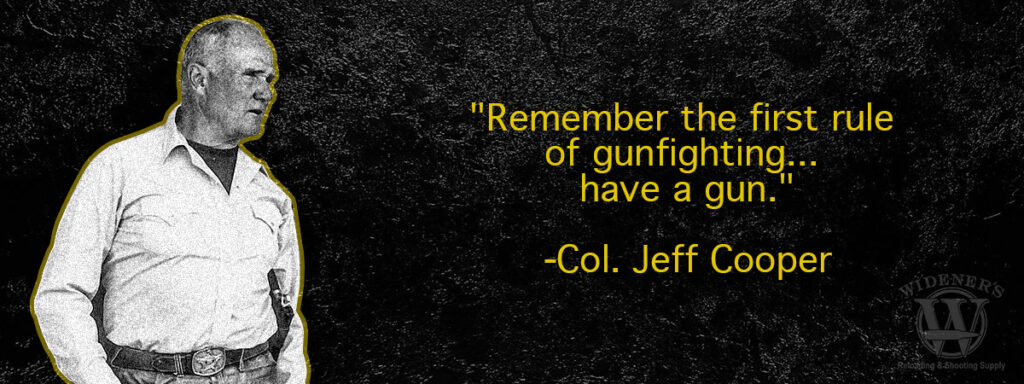

Colonel John Dean “Jeff” Cooper was a trailblazing icon in the techniques of defensive firearms usage. He was also a champion of the philosophy behind it. Many of his quotes, even a decade after his passing, generate a certain reverence for his insight. More precisely for its irreverence for modern, popular political perspectives. He represents a dwindling population that has no toleration for nonsense and calls it out at any opportunity.
“Bushido is all very well in its way, but it is no match for a 30-06.”
-Col. Jeff Cooper
Like an eccentric uncle that creates awkward silences at Thanksgiving, Jeff delivered his views to the public like a kick to the teeth. An individual like this should bless every family. If you had the privilege to grow up with a family member who says what’s on their mind, without regard, then you know what I’m talking about. Watching overly sensitive youngins and privileged progressives get slapped in the face with reality, from someone who served and knows what conflict really is. It provides a necessary balance. The collective family of American gun rights proponents keenly feel his loss.
Cooper’s Beginnings
John Dean “Jeff” Cooper was born in California on May 10, 1920. After earning his degree in political science from Stanford University he received a commission as an officer in the US Marine Corps. Assigned to the USS PENNSYLVANIA in the Pacific Theatre, he earned his way all the way up to major by the time of the Japanese surrender in September 1945.
He returned to active service with the outbreak of the Korean War. He was involved in irregular warfare and earned the rank of Lieutenant Colonel. When the armistice brought active hostilities to an end he was once again decommissioned and went on for a master’s degree in history from the University of California. For the next two decades, he taught history part-time at high schools and community colleges.
“One bleeding-heart type asked me in a recent interview if I did not agree that ‘violence begets violence.’ I told him that it is my earnest endeavor to see that it does…. that any man who offers violence to his fellow citizen begets a whole lot more in return than he can enjoy.”
Hanging With Mr. Cooper
Academically speaking, historians, like the public in general, are divided into two camps. Those who look at humanity’s failure to avoid conflicts as a failure to progress, and those who see the failure to avoid conflicts as the reason to progress. Violence was not something to be avoided but to be understood and, if necessary, responsibly applied.
This did not make him an enemy of peace. But rather one who realized peace for its own sake inevitably failed to bring peace. In other words, to preserve the peace, one had to be visibly prepared to use violence.
Jeff Cooper was no stereotypical, tweed jacketed academic. He didn’t scoff at the madness of the Mutually Assured Destruction philosophy that helped prevent World War III. He was a scholar who applied his own experiences concerning combat into the wider scope of applied social sciences. It is almost comical to imagine how his remarks would fly in a faculty cafeteria today.
Hysterical Hoplophobia
He later remarked that it was during this period, that he first coined the word hoplophobia. He was experiencing the need to have a word to describe what he called a mental aberration of an increasingly consistent, unreasonable terror of “gadgetry, specifically, weapons.” It seemed bizarre to him that society focused so much attention upon a tool rather than the minds and attitudes of those who would cause harm regardless of the tool used.
The Immovable Object
In later life, modern commentators often attempted to take him to task for not being particularly sensitive (PC) for the “modern” age. In 1991, he wrote in Guns & Ammo magazine that “no more than five to ten people in a hundred who die by gunfire in Los Angeles are any loss to society. These people fight small wars amongst themselves. It would seem a valid social service to keep them well-supplied with ammunition.”
He unapologetically stuck to his guns, literally and figuratively, that social responsibility could not function without personal responsibility. To ask law-abiding gun owners to surrender their rights because of the irresponsibility of others was what he found abhorrent.
Realistic Philosophy
You can refer to Cooper’s remarks and philosophy as a mix of the social commentary of Robert Heinlein and the socio-political outlook of Otto von Bismarck’s “realpolitik.” They reflect not only an education in both political science and history but also a lifetime of knowing what violence is REALLY like. His techniques cut through the assumptions of theorists and focused on what worked based on practical experience. An ultimate realist, his teachings in defensive shooting as well as political discourse focused upon one goal: surviving.
American Pistol Institute
In 1976 Cooper founded the American Pistol Institute in Paulden, Arizona, north of Prescott. The intent of the institute was to provide training and skills to responsible gun users. API became the world-famous Gunsite training facility. Many law enforcement and military personnel, as well as private citizens from all over the country and even world visited to hone their skills.
As the original name suggests, the intention was to teach modern pistol techniques. Since its inception, however, the Gunsite ranch expanded its curriculum to teaching techniques for rifle and shotgun as well. Today it remains one of the most popular training facilities in the country. Professionals and enthusiasts alike visit to develop the skills necessary – though hopefully never needed – to use a personal defense firearm.
Jeff Cooper: Defensive Pistol Principles
When he started API, Cooper already developed his core course of modern techniques for modern defensive pistol use. These have coalesced into five basic principles:
- A large caliber pistol, preferably semi auto – Cooper was not shy about espousing his perceived virtues of the 1911 in .45 ACP.
- The Weaver stance, using both hands whenever possible.
- The draw stroke: generally a 5 step process in drawing and shooting defensively.
- The flash sight picture: developing the skills to rapidly and consistently keep your sights on, or close enough on target.
- Finally, the compressed surprise trigger break: the methodology of combining the “double tap” philosophy with putting both shots on target quickly and accurately.
Jeff Cooper: Four Basic Rules of Firearms Safety
Many trainers today credit Cooper with the creation of the Four Basic Rules of Firearms Safety:
- All guns are ALWAYS loaded and you should treat them as such.
- Never let the muzzle cover anything that you don’t wish to destroy.
- Keep your finger OFF the trigger until the muzzle is on target.
- Identify the target AND what is behind it.
For an accident to happen ALL four of the rules have to be broken at the same time, so unsurprisingly, these have become very popular and universal rules instructors teach in virtually every safety course, be it for beginners or trained professionals.
The Bren 10
In 1980, Thomas Dornaeus and Michael Dixon of Dornaeus & Dixon Enterprises began exploring a new pistol to bridge the gap between the power of a revolver with the capacity and quick reloads of a semi-automatic. They wished to consult an expert on defensive pistol use and made contact with Jeff Cooper. While Cooper’s devotion to the .45 ACP was, and remains, legendary, he recommended a new cartridge for the new design.
He recommended what was then known as the .40 Special: a round that would maintain 1000 feet per second out to 50 meters out of a 5” barrel. The 10mm Auto was born. Dornaeus & Dixon supplied the engineering, manufacturing and marketing while Cooper provided technical advice and conceptual criteria. The resulting product was the infamous Bren 10 pistol.
Bren Or Bust?
The Bren 10 provided groundbreaking research and design. Unfortunately, it was a gun that was doomed due to marketing failures and the lack of consumer demand. In fairness, the 10mm is more suited for taking down angry bears, rather than home defense. By 1986 D&D’s Bren 10 was permanently shelved, though Colt flirted with the round for their Delta Elite model 1911. The Federal Bureau of Investigation also briefly adopted the 10mm Auto when they wanted something more potent than the 9mm. The 10’s stout recoil, however, encouraged a new round in 1990, the 10mm Auto short, or more well known as the .40 S&W.
When dealing with close-quarter threats, Cooper continued to rely on a proven 1911 in .45 ACP. It makes sense as the round is slow-moving enough to not over-penetrate the threat at close range, be less likely to cause damage downrange and is accurate when fired out of a proven firearm.
Principles of Personal Defense
Skills and equipment are nice to have. They are only tools, however. To Cooper, the greatest weapon in the arsenal of the citizen was not the weapon or any particular caliber, it was the mindset. In “Principles of Personal Defense“, he was very specific that the ability to survive a potentially or definitive lethal confrontation was rooted in the citizen’s will to react. Decisively and immediately. Without that will, all the best tools and the best scores on the training range matter not a bit.
“The will to survive is not as important as the will to prevail … the answer to criminal aggression is retaliation.”
-Col. Jeff Cooper
This sort of no-nonsense approach is a very serious philosophy because it is on a very serious matter: literally the difference between life and death. Cooper’s experiences made it very clear what hesitation, or a lack of commitment, could mean at the crucial moment. It is what made him a good teacher and his best students were those who grasped that survival could very easily rest on an action of a split second.
Real-World Results
In an age of increasing surrender of responsibilities, and a growing number of “adults” raised on saved levels of video games, the notion of a taking decisive charge in a moment of danger, rather than running and hiding, hoping for the best, it is small wonder that Cooper became a target of “hoplophobes” and social progressives.
“Los Angeles and Ho Chi Minh City have declared themselves sister cities. It makes sense: they are both Third World metropolises formerly occupied by Americans.”
-Col. Jeff Cooper
As he became older mainstream “society” became more and more interested in disarming citizens. It was an easier path than taking responsibility or dealing with social issues decisively. Cooper openly advocated supplying ammo to the criminal elements and letting them sort themselves out. You could argue that he was simply expressing the frustration of watching the next generations fail to accept responsibility for themselves while excusing the irresponsibility of their peers. Many often misinterpreted his observations of firearms responsibility as a curmudgeon who was set in his ways. They saw him as a man who refused to embrace a more modern attitude on society. In actuality, he refused to accept the modern attitude because, from his point of view, there was no “society” to promote.
Defining Courage
His definition of the word hoplophobia clearly pinned the onus of societal failings not on a tool but on attitudes towards an inanimate object. A valuable tool, to be sure, but still an object with no responsibility for how it is used. That fell on the criminals and the society that sought to disarm those who were not intent on crime and harm while failing to curb those who were.
“They [the media] will not accept the truth that if you take all the guns off the street you still will have a crime problem, whereas if you take the criminals off the street you cannot have a gun problem.” Cooper’s philosophy continued to be developed and presented even after he sold the Gunsite firm in 1992. Collections recounting his own experiences as well as books on firearms and self-defense.
Gunsite Gossip Column
Comments and observations from his own column “Gunsite Gossip” were later re-released in Guns & Ammo called “Cooper’s Corner.” These focused increasingly on gun rights, predominantly in reaction to the effort of state and federal governments to restrict rights on law-abiding citizens while doing comparatively nothing against criminals. His own education studying history supported his own philosophies. His experiences also heavily influenced him. These became the building blocks to his doctrines on preparedness and personal responsibilities.
Cooper’s Color Code
Returning to the mindset of the responsible citizen, he prepared “Cooper’s Color Code.” It has less to do with tactical training and more with developing and recognizing an established level of preparedness in response to potential danger. He never claimed to have invented the code. He is however recognized as being the first to use it to indicate a mental state. It was never, as is often mistaken, meant to illustrate the level of danger a person is in. Instead, it describes the condition the mind is in when having to respond to any danger. Here are the colors and their corresponding definitions:
CODE WHITE:
This simply means the defender is unaware and unprepared. Cooper was very clear in suggesting (to outright crying from the highest peaks) that Americans operated increasingly in condition WHITE. When attacked, their reaction was akin to a deer in the headlights. At best a mental reaction of incredulity that they were actually being attacked. Cooper remarked that if anyone survived an attack while in a WHITE state, it was because their attacker was either inept or non-committed.
CODE YELLOW:
This condition reflects a certain awareness of the world around the individual. An acceptance that there are potential threats, but nothing specific. A general readiness characterized by the mentality of accepting that the individual MIGHT have to take responsibility and defend themselves. Other characterizations include keeping one’s head on a swivel, and constantly checking their surroundings. People in a WHITE state consider those in YELLOW paranoid. Those in a YELLOW state consider those in WHITE stupid and/or irresponsible. People in YELLOW also probably make better drivers.
CODE ORANGE:
Takes the awareness of YELLOW but puts a particular or specific, potential threat into focus. Remaining generally aware, people in ORANGE state keep their heads on a swivel. They take particular interest in something that does not look or feel right. Returning to the driving analogy: another car that is having trouble maintaining its lane, or an area where you have seen a speed trap before. In a defensive situation, it may be a particular individual that has gained your attention. In ORANGE, the mind prepares ready actions. “If that person does X, I will do Y.” The Fight or Flight subroutine is spooled up in your mind, but with a ready plan of action to fight in case flight is not an option.
CODE RED:
Using the parameters established in ORANGE. RED means that the potential threat has become legitimate, they have done X and the fight is on.
As stated above, Cooper became increasingly vocal about the how people were becoming conditioned to remain in WHITE. It meant that they did not have to take responsibility for themselves. Or for anyone else, and could continue to blame others – ironically those who walked around in YELLOW or ORANGE most of the time – for the ills of society.
The Scout Rifle
While the Bren 10 failed to launch, the 10mm did find its niche’ in modern pistol calibers. Cooper became widely known for his work with defensive pistols, and soon other manufacturers took notice. In the1980’s Cooper, devoted some thoughts to a tactical rifle. One that was suitable for multiple purposes from hunting to personal and even civil defense.
The parameters were for firing a .30 caliber rifle bullet, an overall length of under 40 inches, weighing under 3 kilograms, utilizing both iron sights and a long eye relief scope and, interestingly enough, a bolt action. One wonders if this was meant to circumvent, or at least forestall bans on semi-autos that were already becoming popular in other countries. He called it a “scout rifle.”
In 1997 Steyr introduced their Scout model after long consultation with Cooper. While not a commercial success, it was not a flop either. Other manufacturers such as Ruger, Mossberg, and Savage produce scout models. The rifle is intended for a general-purpose. Many shooters have found a scout to be a good general companion firearm.
The Wisdom Of Jeff Cooper
“A free man must not be told how to think, either by the government or by social activists. He may certainly be shown the right way, but he must not accept being forced into it.”
-Col. Jeff Cooper
Perhaps one of the most pertinent “Cooperisms”, the more pressure that is applied from others to think a certain way, the more an independent thinker will resist. It may not have been the message of social activists that Cooper chose to object to but how they chose to express their message: by attacking guns and those who made improving their skills with guns. To Cooper, and many other pro-gun rights people, the guns are not nor were they ever the problem. They are certainly a component of the problem, but even without them, the problem remains.
Armed Men Are Free Men
Many social activists condemn guns because they make it “easier” to kill. That’s sort of the point, to be an equalizer. A 95lb asthmatic can definitively defend themselves against a 300lb brute intent on doing harm. This simple arithmetic often escapes progressives who think that ill will is something that is exclusively influenced from without rather than also cultivated from within.
Cooper understood that legislating guns away from the public was only a small part of the problem. The larger issue was a false social construct. One that was intent on disarming the populace of reason and will, of the mindset to act when necessary. He was not just talking about the direct attack of a mugger, but the steady erosion of “society” through the demand of conformity in defenselessness. Whether it be against criminals on the street or those in the capitol. Small wonder his copious quotes are often questioned by those who refuse to understand the virtues of violence.
John Dean “Jeff” Cooper continued to live in his Paulden ranch after selling the Gunsite firm for another 14 years, penning observations and delivering advice to students, readers and manufacturers alike. He died on September 25, 2006, his wife Janelle passed in 2019. They are survived by his three daughters, who continue to maintain his library and museum.








